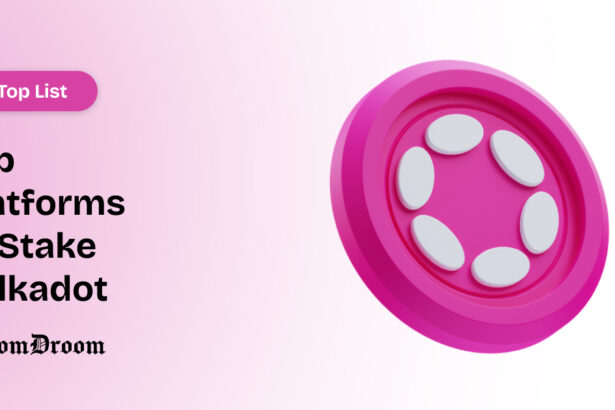Staking is one of the most remarkable activities that blockchain users can engage with. It offers some key benefits, including passive income and governance rights to asset holders. The users also contribute to the overall network management by validating transactions. They maintain the ecosystem’s integrity and receive rewards for it. Polkadot is a very popular network for this task.
Polkadot has become a go-to option for staking due to various reasons. It makes passive income easily attainable while letting users participate in the network’s security. They also gain the status of validators or nominators, bringing stability to the overall mechanism. Moreover, they get to vote on new proposals. The platform also helps reduce inflation, gives various staking options, and makes joining easy.
Due to all those benefits, staking on Polkadot hasn’t remained an exclusive activity to this platform. Various exchanges have started offering it as a service. Thus, if you’re interested in this activity, knowing about the top platforms to stake Polkadot is a must. With their knowledge, it is easier for the crypto users to choose the best alternative. So let’s dig into these alternatives and see how they make staking better.
Top Platforms to Stake Polkadot
These Top Platforms to Stake Polkadot bring ease, efficacy, and high accessibility into staking. They enable users to experience the power of decentralized finance.
Binance
Binance is known for simplifying the staking process. Users can join it with just a few clicks and start gaining rewards. Along with Polkadot, it supports the staking of Ethereum, BNB, and Cardano. Interested users just have to submit a request quickly. There’s a brief bonding period after the validator nodes start their work. Every network has its own conditions for staking that need to be met.
Soon after that, the stakers start to receive the rewards. Currently, the platform doesn’t allow lending or borrowing of staked tokens. In addition, Binance makes it clear to users that it makes staking available as a consensus model. Its priority is to enhance participation in the blockchain network, but not doling out rewards. Staking is offered as a third-party service to all its asset holders.
Kraken
Kraken makes staking more inclusive and convenient for asset holders. The platform offers high-grade security and potential rewards while bringing support to the underlying blockchain. It applies a slashing function and seizes validators’ assets if any malicious activity is noticed. Furthermore, it brings an unbonding period, which means users can’t withdraw their tokens after a certain period of time. Many users consider it one of the top platforms to stake Polkadot.
Besides Polkadot, the platform supports staking of Bitcoin, Ethereum, and Solana. It also offers opt-in yield products for some cryptos, including EUR and USD in select regions. Kraken implements on-chain staking that makes the rewards more lucrative. It handles the complications of this process without having users deal with asset management. It may have different payout intervals and payout structures.
Lido
Lido is a liquid staking solution that facilitates the process without requiring users to lock their assets. They also don’t have to participate in the validation operation. Users receive staked tokens in return, which they can utilize in accessing different DeFi solutions. It counteracts the problems of entry barriers and illiquidity. Token holders can participate in this mechanism with a very low count of assets. It’s surely among the top platforms to stake Polkadot.
It also simplifies staking, reducing the complexities of validators’ tasks. On top, it encourages decentralization and streamlines the process of distributing staked tokens. Lido makes lending and borrowing more accessible for users. It brings forth a Community Staking Module (CSM), which reduces the upfront investment for running validators. It even enhances yield opportunities for participants.
Coinbase
Coinbase is renowned as one of the most user-friendly exchanges globally, making it an ideal platform for beginners looking to stake Polkadot (DOT). It combines secure custody and compliance features with the convenience of automatic rewards payout, allowing users to stake without worrying about a minimum amount or the need for active management.
Key benefits of using Coinbase include its intuitive user interface, which caters to newcomers, and the absence of lock-up periods for certain staking options. Furthermore, the platform offers regulated and insured custody, supports staking on both web and mobile apps, and maintains transparent fees along with clear reward schedules. This combination of wide adoption and simplicity effectively helps onboard new users to Polkadot staking with confidence.
Crypto.com
Crypto.com is a mobile-first platform that stands out for its flexible staking options, offering varied annual percentage yields (APYs) depending on the chosen lock-up terms and additional staking of CRO tokens. Users can select from three tiers for Polkadot staking: flexible, 1-month, and 3-month lock periods, with the rewards scaling accordingly.
The platform features both flexible and fixed-term staking plans, with APYs that range from approximately 1% to 14.5%, depending on the amount of CRO staked. Notably, there are zero platform commission fees for staking, making it an attractive option. Additionally, the minimum staking amount is as low as 1 DOT, which encourages participation. The user-friendly app integration simplifies staking and portfolio management, making Crypto.com ideal for mobile users who seek flexibility with their DOT holdings while earning competitive APYs.
KuCoin
KuCoin is well-known for its extensive selection of cryptocurrencies and staking products, particularly highlighting its Polkadot staking options available through the Pool-X platform. Users can enjoy flexible terms with a minimum staking requirement of only 0.2 DOT. The platform offers an attractive annual percentage yield (APY) of up to approximately 7.3% for DOT staking, along with the ability to quickly withdraw rewards.
Additionally, users have the option to participate in Polkadot parachain slot auctions by staking DOT in specific projects, further enhancing their engagement with the ecosystem. However, it is important to note that there is a 15% commission fee on rewards. Overall, KuCoin caters to users seeking both liquidity and an active role in Polkadot’s parachain bidding landscape.
Ledger Nano Hardware Wallet
For users looking for maximum security, staking via Ledger Nano hardware wallets is a strong choice. Ledger users can stake DOT using the Polkadot Staking Dashboard interface while keeping their assets offline. This approach offers several benefits, including maximum security by storing private keys offline, the ability to participate as nominators by carefully choosing validators, and the opportunity to stake starting from around 80 DOT.
Additionally, the average staking annual percentage yield (APY) can be as high as 14%. While there are no staking commissions involved, it’s important to note that there is an upfront hardware cost. This method is particularly well-suited for seasoned investors with significant DOT holdings who prioritize security over convenience.
How to Choose the Right Platform for Polkadot Staking?
When deciding where to stake Polkadot, consider the following:
- Security: Hardware wallets like Ledger offer the highest protection but require technical know-how.
- Ease of Use: Exchanges like Coinbase, Binance, Kraken, and Crypto.com offer simple onboarding.
- Rewards/APY: Platforms vary in their yield rates; liquid staking services like Lido and staking specialists like Keynode provide high returns.
- Lock-up Terms: Some platforms have flexible access, while others require fixed terms — choose based on your liquidity preference.
- Additional Features: Consider governance participation, loan/lend opportunities on liquid staked tokens, and any platform fees or commissions.
- Reputation and Support: Established platforms with good reviews and customer service reduce risks.
Upshot: Top Platforms to Stake Polkadot
Staking of Polkadot gives numerous benefits to its holders. Furthermore, the process is accessible to everyone. The mechanism also offers high stability and resilient security. Users can contribute to the improvement of the network and become a part of it too. Most platforms make joining the program quite cheaply by letting users start with a low amount of tokens. They also provide rights of governance to stakers.
That’s why knowing about the top platforms to stake Polkadot is a must for crypto enthusiasts. With them, digital asset holders unlock the true potential of blockchain. They earn more and enjoy exclusive merits, high-grade security and egalitarian governance.
Frequently Asked Questions
Why is Polkadot considered one of the best options for staking?
Users can earn passive income with Polkadot whether they are securing and decentralizing the network, or simply giving the opportunity to a token holder to be a nominator or a validator, participate in governance decisions, support uptime to the ecosystem, and earn rewards in the process.
What are the main benefits of staking Polkadot on exchanges and platforms?
Using some exchanges or liquid staking services for staking creates a simplified pathway. The user does not need any technical ability to manage validator nodes on their own, and also, in most cases, lower barriers to entry, fewer lockdown periods, and automatic payout of rewards.
Which are some of the top platforms to stake Polkadot?
Staking is available on a number of platforms, but the top Platforms to stake Polkadot are probably Binance, Kraken, Lido, and for exchanges like coinbase. A larger blockchain ecosystem, like native polkadot staking, allows for direct participation on its own. Some staking ecosystems provide a much wider range of options and more value, risk factors, flexibility and yield potential.



















